Mrs. Homegrown here:
Where we live, this is the poppy time of year. California poppies (Eschscholzia californica) are blooming all over our neighborhood, and most especially in our yard. I have to admit I have a mercenary attitude toward plants, my main thought on meeting one being, “What can you do for me?” California poppies, lovely as they are, have become more interesting to me since I’ve started consuming them. Now, don’t get concerned (or intrigued): the Root Simple compound has not turned into an opium den. California poppies are not part of the famous Papaver somniferum species, and they can’t get you high, nor are they addictive. However, they can help you relax.
I’m all for using plants that grow readily in your yard or general area, rather than trying to coax more exotic species along. There are many herbs that can be used to make relaxing teas (valerian, catnip, linden, chamomile, etc.), but this one intrigues me because it’s essentially a weed where I live. If it doesn’t grow readily where you live, I’d encourage you to investigate other herbs which grow more easily in your area.
But for those of you who can grow California poppies easily, I’ll just say that I’ve been making tea with fresh California poppy foliage this year and must report that I really like it. I like it so much that I’m drying plants so I have a store to last me through the summer and fall, and may make a tincture of it, too.
It makes a soothing tea. I find it useful in two types of situations: first, when I have a nagging tension headache–the kind that comes about when you’re cranky, and can’t find any way to de-crankify, because your head hurts so damned much. I find that this tea de-tangles my brain enough that the headache goes away. The second situation I take it in is when I’m really tired but am resisting going to bed for whatever reason.
What do experts say?
There’s lots of somewhat conflicting information about the California poppy on the Internets, and even my herb books at home say different things about its properties. Overall I think all sources do agree that it does have sedative quantities and that it won’t hurt you. In fact, in Europe, it’s often used as a component in sedatives for children. Taking that as a starting point, I’m trusting my own evaluation of its effect in regard to me. Everyone reacts a little differently to herbs, and everyone has different needs, so I’d encourage you to try it and see what you think.
In Medicinal Plants of the Pacific West, Michael Moore says its a “…surprisingly effective herb for use with anxiety” and “When used as a sedative, it promotes relaxation and genial lethargy.” He notes it has some mild analgesic effects in higher doses.
One thing he does address is the question as to whether drinking this tea would make you test positive on a drug test. His answer is that though the plant does not contain the same alkaloids found in opiates, it contains alkaloids that are similar enough that they might create a false positive on an urine test. I’ve also heard firm opinions from other sources that it absolutely will or will not show up.
California Native Americans use Eschscholzia in their own way. According to Healing with Medicinal Plants of the West, the Chumash made a poultice of the pods to stop breast milk. For them, this was (is) the plant’s primary use. Secondary uses include using the root for toothache and a decoction of the flowers to kill lice.
How to use:
You can make tea with any of the above-ground parts of the plant: leaves, stems and flowers. You can use these parts fresh or dried. I’ve been using fresh so far. I just stuff my tea basket with fresh leaves, pour hot water over them and let it steep a good long time–maybe 10 minutes. I put a saucer over the top of the cup to help keep the tea warm. The long soak ensures a stronger, more potent brew, obviously.
All the sources I’ve read note that this tea is unpleasantly bitter. I’ve not found that to be so, but my palette may be affected by Erik’s ongoing fascination with bitter Italian greens. Sometimes I throw some mint in with it just to liven up the flavor, but I honestly don’t find it unpleasant straight.
(ETA: Coming back in September to add to this post. Now that summer is almost over, I can say that the plants get more bitter as they get older and the weather gets hotter. It’s the first flush of growth that’s most palatable.)
In terms of dosage, all I can say is that the more of the tea you drink, and the stronger you brew it, the more pronounced will be the effects. If I just want a bedtime brew, analogous to chamomile, I’d just make a cup of tea as I’d make any cup of tea. If I have a headache, I’ll make a small pot of tea (2-3 cups) and brew it strong and sip it until I feel better.
You can also tincture the plant, fresh or dry, in alcohol, and take it in that form. This isn’t the place for a tincture how-to, but if you already know how, Moore says: Dried plant tincture: 1:5, 50% alcohol; Fresh 1: 2; Both 30-60 drops, up to 4x a day, for anxiety.
I’ve heard that the root can be held against a sore tooth–in places other than the Chumash source–but I don’t know if it works. Some sources I’ve read use the root as well as the above ground parts for tea, but I’ve not tried it. I’ve decided that the root must have slightly different properties than the foliage and haven’t stirred myself to investigate those yet.
Growing California poppy:
If you live where this plant is native, all you have to do is throw some seed around your yard in the fall, and the plants will magically appear after the winter rains. There is no special care or soil prep to be done. You don’t even have to bury the seed. The plants will thrive on their own until the summer heat and dryness kills them. Before they go, though, they will spread seed and more plants will appear the next year on their own. I’m not so sure how you’d grow it in other climates, but I assume you’d toss the seed around after the last chance of frost. If anyone has experience growing California poppy in other climes, please let us know what you do.
Nanny state precautions:
You should maybe not drink a lot of this and then drive, or operate drill presses, table saws, curling irons, etc. You probably should not mix this with prescription drugs without consulting your physician, especially if you’re on sedative drugs. If you’re pregnant or breast feeding, you know the usual drill–consult your practitioner. And anyway, that part about drying up milk might be of concern. Finally, California poppies are protected by state law. It’s illegal to pick them except in your own yard.

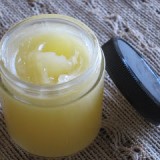
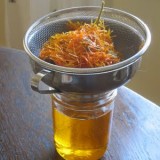

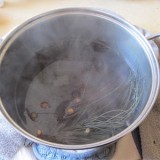
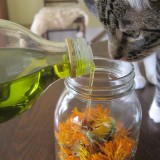
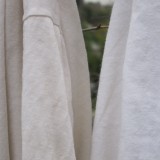
Where I am we don’t have poppies in bloom – just a few brave, pallid daffodils. I do have a headache, and it would be alleviated just by looking at those beautiful flowers. Are they fragrant? That’d be even better. No tea needed 🙂
@Terry. Sorry about the headache! The flowers don’t have much of a scent, unfortunately. They can’t be brought indoors as cut flowers, either. They open and close with the sun, and will not stay open if cut. They’re very much wild flowers.
This is good to know, although I’d like to see if they can be grown up here in the Portland area, which is fairly mediterranean in climate. I wonder how they would fair against the dandelions?
Kelly- do you know if they make good bee forage?
In my Southern California yard the poppies coexist quite peacefully with dandelions. I’m sure that’s not what you hoped!
Hi Paula – I’m late to the comment party here and you’ve likely found an answer, but nevertheless – here’s mine….I live in Eugene and I see these many places – in people’s gardens and there are also whole vacant lots and other, fallow sites that are simply covered with them.
Thanks for this article, guys! I’m actually particularly interested in the stoppage of breastmilk and have filed away that little piece of information for when I need it. Engorgement is not fun, and if California poppies help, awesome. I have a little booklet on plans that the Chumash used. I haven’t read it in a while – I wonder if the poppy’s listed in my booklet. Anyway, thanks again!
Paula – I’ve seen patches of California poppies here and there around SE Portland. and they are good for bees, although I’m not sure what kind of bees (just read an article this morning in an old edition of Mother Earth about bee types).
Awesome info!! Just sprinkled some seeds so now Ive got another use besides beauty!
@Paula: Bees visit ours, but I wouldn’t say they are insane about them the way they are about borage or poppies or rosemary. It’s that purple thing. They may well be good for native pollinators.
@Hybridhopes: The exact quote is: “the seeds or seed pods were boiled, mashed and rubbed on the breasts to stop milk production.”
You’re making those of us on the East Coast jealous 🙂 I love making tea from foraged herbs that others consider to be weeds. Bee balm is an invasive mint species here that makes a fabulous cool tea drink in the summer.
I wonder if color affects potency. I have cream colored California Poppies instead of the regular orange ones. They also have red and yellow ones. Chose the cream colored to give the eye a rest in our busy garden.
I grew some this year. Time to make some tea!
What a great post. The bit about the use related to lactation is really interesting to me. We couldn’t get one of our goats to dry off this winter. I bet this would have helped. Please repost a reminder to spread seed in the fall!
Does the book have illustrations or photos of all the plants? I would really enjoy this book, if the plants were easily identifiable.
they were giving away seeds at an earth day fair at work 🙂 i cant wait to get these planeted they are really pretty plus the medicinal benefits woudl be great
Harvested a bunch from my garden here in Michigan. Can’t wait to steep some, thanks for the article.
I live in central Georgia. This year I am making my first attempt at growing california poppy for medicinal uses. (My wife has developed medical issues and is extremely medicated now and want to try using more natural remedies where possible) Here they are grown a lot in outdoor planters as ornamental flowers thru early spring to early summer when they tend to wither away and then they return again in early fall until first frost which is usually end of october – early november.
Having lived in various regions of the country I have yet to find a climate, that with a little experimentation and common knowledge of the plants extreme limits for heat and cold, they can’t easily be cultivated.
Thanks for the info., Brian. CA poppies have always struck me as hardy plants.
In case you haven’t thought of it, you might want to consider making a tincture instead of doing the tea. I’ve got a tincture brewing now and if I like it, it will be a good thing, because I’m trying to save cabinet space. Also, tinctures last longer than dried material, which is convenient.
And of course you might want to run the poppies by your wife’s doc to make sure there are no chemical conflicts–but I’m sure you know that.
I live in the desert of Nevada. my calif. poppies have been blooming for three years now. seems they got taller this year. they don’t take a lot of water. and i have a zeroscape yard – so they actually grow in the rocks. very hardy. i would like to know how to process them for baking. don’t use insecticides – so no worry there. and
THANK YOU FOR THIS POST. i now know how to prepare for making teas, etc. i’m assuming the pods should be harvested
also, when the poppies “pop” they spread into a large area on their own.- so i have more and more poppy plants each year. – that is to say the seeds the doves don’t feast on – saying this to emphasis how wild this plant actually is. i don’t need to “wait for the last frost”. they are already there waiting their time to delight the neighborhood with their cheery yellow blooms.
I bought tea from our farmers market that is made with California poppies. I must say does help u relax. I suffer from restless legs and am up once or twice a night, when I drink this tea I sleep all night without problems. So I guess there is some truth to the effects 🙂
Hello!
Californian poppy grows and blooms well here in Finland. We grow californian poppies as annual ornamental plants.
Hello, I’m waaaay late for this article, but I thought I would add for anyone coming across it as I have.
I would think Cali poppy would grow just about anywhere as it seems to have persisted here in my yard and along the highways in the Seattle area. It even held up during the great freak snow of 2011 when temps lowered to a brisk 15 degrees. I couldnt say if it is medicinally viable any time other than spring to fall, but east coasters, maybe you should let it invade ;D
Great blog by the way. I enjoy it much.
Hello,
I have to add my two cents. I live in Ohio and I tried planting California Poppy last year with no results :[ (I think I used to much Peat Moss and snuffed out the seeds). Then this year I have hardey gorgeous flowers and how they open and close is awesome! Your post helped me out cause I’ve been trying to grow medicinal herbs to create teas for natural healers. It worked for our ancestors! Pharmaceuticals are for profit and mother nature is free to enjoy
Thanks for the tea idea, I was just going to make a tincture. I will still tincture the root and await further developments. Lots of the plant here in the Willamette Valley (Oregon).
Bruce,
I’ve made the tincture too since this post, and it works really well! I was thinking about posting about it soon. The tincture is better, since it keeps forever.
what is tincture? i am just getting ready to harvest my first batch of cal. poppies….hope they don’t come up positive on my union drug test!!
Doug,
If perchance you happen to ‘pop positive,’ what you need to do is =make sure= that your sample is processed through a Gas-Liquid Chromatograph (GLC), because it fully evaluates just what chemicals are present in the urine sample.
A GLC test will reveal whether the positive result was caused by a psychoactive substance, or a non-psychoactive substance. Even though the chemistry is similar, they aren’t exactly the same, and so therefore will be seen as distinct unto themselves when analysed via the GLC.
Otherwise, the basic urine test is a simple reagent analysis, itself which isn’t definitive in and of itself, i.e., it is a ‘general’ test. So again: Make sure that you provide a subsequent sample to be sent to a lab which uses as GLC for analysis.
Regarding the growing of the California Poppy outside that location, let me say that I’ve been growing them quite successfully for a number of years, here in northwest Washington (state).
I have them planted in a gravelly strip next to the westside of my garage that drains fairly well. That location gets plenty of rainwater, and sun only from midday to late afternoon. The temps at my location have been as high as upper 90’s, and as low as the single digits. I haven’t ever seen them die off, and they appear to be green all year long, with blooms in the spring to middle summer.
I was in the process of researching drugs derived from plants and came across this website. Thank you for the very interesting information. Since I am a sufferer of headaches and sleeping disorders, I will try this solution because I hate taking pills. I live in California in an area where I do not see very many California poppies, but I think I am going to plant some in my garden and see what happens. Thanks for the info.
I’m so happy that these cheerful flowers — known by all around as an annoying weed — are medicinal.
Life is easy sometimes 🙂
The so-called ‘weeds’ in life, will be found to be the diamonds in the rough: The unsung heroes.
Passion flower is amazing however I like kanna more and they are a dangerous combo. Blue Lilly is also a fave. For pain white willow bark is safer than aspirin and for extreme pain kratom will take care of it but don’t use often, it can be addictive. I smoke lavender and uvis ursi over cigs now. The uvis ursi has helped aid in quitting the hardest analogs of already heavy drugs. 6 months clean and should be dead. On paper I have the mental capacity of a 9 year old. I actually have never felt more aware and my silly iq test was 134. So, believe in something big. My daughter is my higher power so to speak. Haha.
Can the leaves, stem, and petals all be used for tea, or just the leaves? Is one flower = one cup of tea, or how many plants should I be using?
I live in Black Hawk, CO at 9000’elevation. Growing season from mid June to mid-September. This is the last week in July and I have California poppies blooming as of this week. Scattered seed after last frost (sort of – last snow was May 23 and last frost was June 12) and I expect to see flowers until, with some weather cooperation, until October.